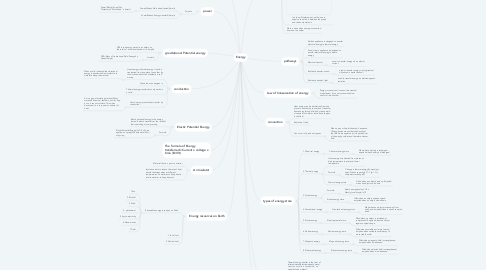
1. efficiency
1.1. Formula
1.1.1. 1.Energy Efficiency=Useful Output Energy/Total energy input x 100%
1.1.2. 2.Energy efficiency=Useful Power Output/Total Power Input
2. power
2.1. Formula
2.1.1. Power(Watts)=Work done(Joules)/time(s)
2.1.1.1. Power(Watts)=Force(N) x Distance(m)"Work done" x time(s)
2.1.2. Power(Watts)=Energy transfer(J)/time(s)
3. gravitational Potential energy
3.1. GPE is the energy stored in an object as the result of its vertical position( i.e, height)
3.2. formula
3.2.1. GPE=Mass x Gravitational Field Strength x Vertical height
4. conduction
4.1. Heat energy is thermal energy. It can be transferred from one place to another by conduction without the substance it self moving
4.1.1. When a solid is heated the vibrational energy is transferred from molecule to molecule along the material.
4.2. Conduction can happen in
4.3. Thermal energy transfer that only works in a solid
4.4. How does air prevent heat transfer by conduction?
4.4.1. Air is a good insulating material. Many materials like wool, feathers, and fur trap air so it cannot circulate. This works because air is a very poor conductor of heat.
5. Elastic Potential Energy
5.1. Elastic potential energy is the energy stored in elastic materials as the result of their stretching or compressing
5.2. Formula
5.2.1. Elastic Potential Energy(J)=1/2 x Force applied on spring(N) x extension(N/m) of spring
6. The formula of Energy transferred= Current x voltage x time (E=IVt)
7. An Insulator
7.1. Material that is a poor conductor
7.2. Insulation aims to reduce the rate of heat transfer between areas at different temperatures. Sometimes to keep heat in, and sometimes to keep heat out.
8. Energy resources on Earth
8.1. Renewable energy resources on Earth
8.1.1. 1.Sun
8.1.2. 2.Bio fuel
8.1.3. 3.Wind
8.1.4. 4. geothermal
8.1.5. 5. hydro-electricity
8.1.6. 6.Water waves
8.1.7. 7.Tidal
8.2. 1.fossil fuel
8.3. 2.Nuclear fuel
9. pathways
9.1. Kettle's appliance is designed to transfer electrical energy to thermal energy
9.2. Food mixer's appliance is designed to transfer electrical energy to kinetic energy
9.3. Electrical transfer
9.3.1. used to transfer energy via an electric current
9.4. Radiation transfer: sound
9.4.1. used to transfer energy via longitudinal vibrations in matter (sound)
9.5. Radiation transfer: light
9.5.1. used to transfer energy via electromagnetic radiation
10. work done
10.1. Formula
10.1.1. Work done(J)=Force(N) x Distance(m)
10.1.2. Work done(J)=Mass (g) x Graviatational acceleration (10N/kg) x Height (m)
10.1.2.1. Force(N)=Mass (g) x Acceleration(m/s^2)
10.2. In a force-Displacement, work done is equal to the area in between the graph and the horizontal axis
10.3. Work is done when energy is converted from one to another
11. convection
11.1. Heat energy can be transferred from one place to another by convection. It transfer heat energy through fluids by the upward movement of warmer, less dense, regions in the fluid.
11.2. Radiation, fluids
11.3. Can occur in liquids and gases
11.3.1. When a gas or liquid is heated it expands. The expansion means that the density of the fluid floats upwards as it is pushed out of the way by colder, and therefore denser, fluid
12. types of energy store
12.1. 1.Chemical energy
12.1.1. Chemical energy store
12.1.1.1. filled when a battery is recharged emptied when battery is discharged
12.2. 2.Thermal energy
12.2.1. Heat energy is transferred from places at high temperature to places at lower temperature
12.2.2. Formula
12.2.2.1. Change in thermal energy(J)=mass(g) x specific heat capacity(J C^-1 kg^-1) x temperature change(C)
12.2.3. Thermal energy store
12.2.3.1. Filled when an object heats up. Emptied when an object cools down.
12.3. 3.Kinetic energy
12.3.1. Formula:
12.3.1.1. Kinetic energy(Joules)=1/2 x Mass(g) x velocity(m/s)^2
12.3.2. Kinetic energy store
12.3.2.1. filled when an object speeds up and emptied when an object slows down
12.4. 4.Gravitational energy
12.4.1. Gravitational energy store
12.4.1.1. filled when an object moves away from earth, and emptied when it moves towards earth
12.5. 5.Elastic energy
12.5.1. Elastic potential store
12.5.1.1. Filled when an object is stretched or compressed. Emptied when the object regains original shape.
12.6. 6.Nuclear energy
12.6.1. Nuclear energy store
12.6.1.1. Filled when unstable nuclei are formed, emptied when unstable nuclei decay to more stable nuclei
12.7. 7.Magnetic energy
12.7.1. Magnetic energy store
12.7.1.1. Filled when magnetic field is strengthened, emptied when it weakened
12.8. 8.Eletrostatic energy
12.8.1. Eletrostatic energy store
12.8.1.1. Filled when electric field is strengthened, emptied when it is weakened
13. Law of Conservation of energy
13.1. Energy is conserved, it can not be created or destroyed. It can only converted from one form into another
14. Radiation
14.1. Thermal energy transfer in the form of infrared waves(electromagnetic wave) ,that can occur in a vacuum (i.e. no particles)(only method)
14.2. How does radiation work in electric heaters?
14.2.1. Answer:IR waves are part of the electromagnetic spectrum. They travel at the speed of light in space and almost as fast through air. Radiant heaters are placed high up in a room because heat can travel in any direction - the heat from radiant heaters is felt almost instantly when the heating element starts to glow.
